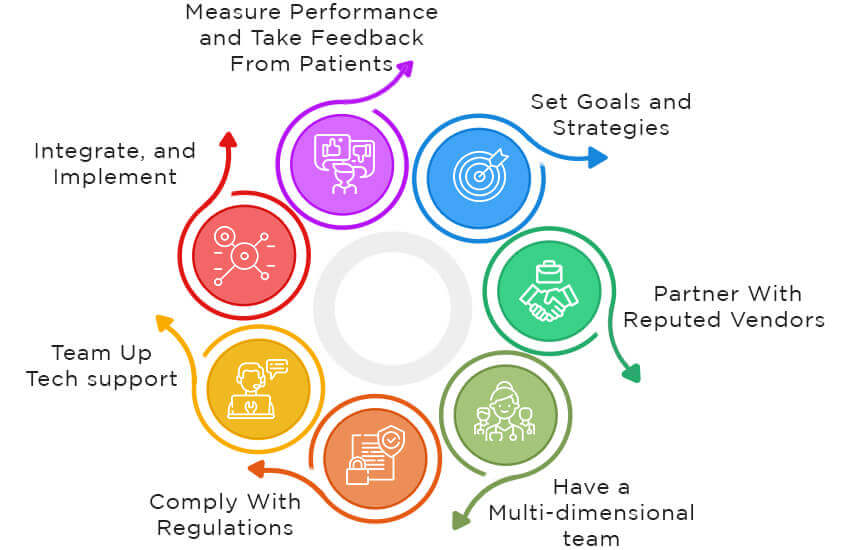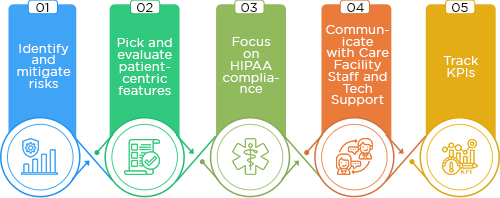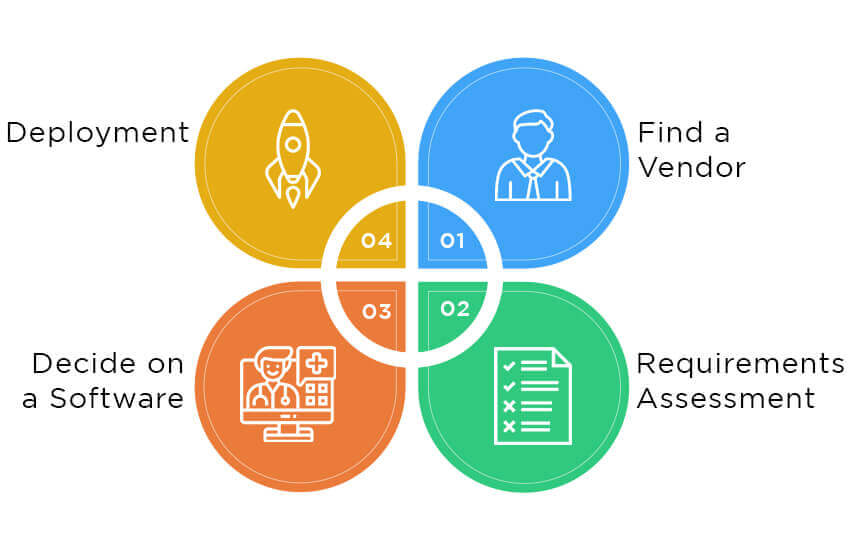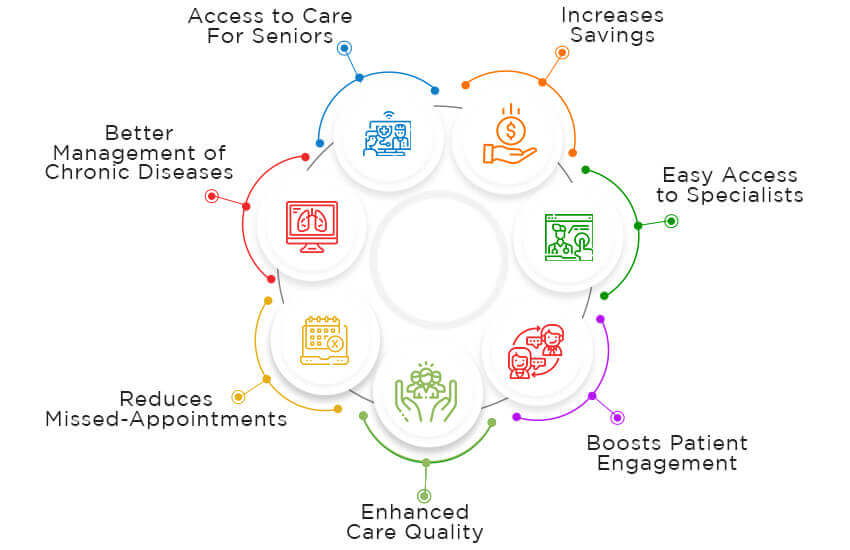Introduction:
The global health crisis COVID-19 highlighted how important are telemedicine/ telehealth services. Although telehealth existed before that, it has been gaining popularity in the last few years. Today, care facilities, home-care centers, behavioral therapy centers, and hospitals have either implemented Telemedicine or looking forward to it.
Telemedicine implementation in care facilities has boosted their care delivery and patient engagement systems. Like mHealth, electronic health records, or any other custom healthcare solutions, Telemedicine offers a myriad of benefits. However, it’s important to follow the best practices for telemedicine implementation.
Telemedicine implementation in hospitals and care facilities covers diagnosis, regular tracking of medicines, emergency care, and more. So, if you’re interested in investing in telemedicine implementation, best practices and capable telemedicine software companies are the best aids. And here are the five best practices for telemedicine implementation in your care facility.
How to Successfully Implement Telemedicine Program at Care Facility
Telemedicine implementation in healthcare is not an uphill task. Hospitals can effectively deliver advanced telemedicine services with the right telemedicine implementation strategies. So, here are some of the steps to implement a telemedicine program.

- Set Goals and strategies- Just setting up telemedicine software is not enough. Healthcare provider solutions must always have a goal and strategy for it. So, if you’re trying telemedicine implementation at your care facility, then you need to set your care goals and develop strategies to achieve them.
- Partner With Reputed Vendors-This is perhaps one of the essential steps in the telemedicine implementation journey. There are numerous companies offering telehealth systems. So, it is necessary to choose the right one for your organization. Choosing a company with a good track record with medical technology and custom healthcare solutions is highly recommended.
- Have a multi-dimensional team- Telemedicine software requires multiple providers or staff. Even services from different businesses or healthcare facilities are required. So, it’s essential to gather a cross-functional team to make the implementation process easier. Telemedicine programs might require healthcare automation or healthcare analytics solutions to drive further care and growth decisions.
- Comply with regulations- HIPAA compliance is a must, whether it’s a telemedicine software platform or a telehealth app for patients. Complying with regulations assures patients and Stakeholders of privacy and security.
- Team up Tech support- Technology plays a crucial role in telemedicine implementation. It’s required to team up with reliable IT support partners to implement telemedicine software successfully.
- Integrate, and implement- The last step is to integrate the telemedicine software into your existing system or implement it separately. Besides, you can use cloud-computing solutions in healthcare to develop telemedicine programs. Cloud-based telemedicine solutions are a better option and easier to integrate as well.
- Measure performance and take feedback from patients- Just implementation of Telemedicine isn’t enough. With integration and implementation, providers need to track the performance of telemedicine solutions. Besides, feedback from patients is equally important for improving the telemedicine software.
The 5 Best Practices For Telemedicine Implementation
Telemedicine implementation is easier with the right set of goals, some great strategies, and an excellent cross-functional team. However, hospitals with integrated care management need to adopt these five best practices to implement Telemedicine. Telemedicine implementation will also boost other solutions like electronic data exchange or healthcare interoperability. Data generated from Telemedicine is critical and helps in improving care quality. So, providers also use clinical data analysis to manage telemedicine software data.

1. Identify and mitigate risks
One of the essential practices in telemedicine implementation is identifying the risk factors and eliminating them. Implementation of telemedicine software for providers is affected by several challenges, including reimbursement and cost of adoption issues. As providers, it’s essential to identify the potential risks affecting telemedicine implementation. Besides, providers can use tech solutions to mitigate these risks and boost the implementation process. For instance, if your hospital implementing Telemedicine requires data management solutions, you can use clinical informatics solutions. This will make the implementation process faster.
2. Pick and evaluate patient-centric features
Telemedicine or telehealth solutions enhance patient experiences. And patients also look for features like data transparency, appointment scheduling, emotional connectivity, and test results. Besides, you can consider features like mobile app support, integration with wearables to monitor remotely, and more. They are ensuring that the telemedicine software platform has patient-centric features. However, providers also need to understand patients’ expectations and needs to select features of the telemedicine software. Above all, considering patient-centric features mean improved feedback from patients. And this is an excellent way for telemedicine implementation in hospitals.
3. Focus on HIPAA compliance
Technological solutions in integrated care management systems need to maintain their processes and data privacy and security. So, developers of these tech solutions are attentive towards HIPAA compliance. Even in telemedicine programs, providers and developers need to ensure that their software complies with HIPAA regulations to maintain security. Moreover, complying with regulations also assures patients of the authenticity of the software. So, when implementing Telemedicine, it’s best to ensure regulatory compliance with HIPAA to boost its performance.
4. Communicate with Care Facility Staff and Tech Support
Another critical practice impacting telemedicine implementation in healthcare is apt internal communications. Communicating with care facility staff or tech support timely with your requirements and suggestions effectively implements a telemedicine program. Even with patients, communication related to telehealth solutions is beneficial. So, successfully implement Telemedicine in hospitals with this good communication practice. Further, maintaining proper communication between the stakeholders can boost the integrated healthcare systems.
5. Track KPIs
KPIs or Key Performance Indicators monitoring is a must when implementing telemedicine software. KPIs include patient satisfaction scores, scheduling statistics, telehealth reimbursements and revenue generated, and productivity of care providers. Tracking these aspects when implementing Telemedicine will help providers determine its success. Further, maintaining this practice is quite beneficial for providers who have implemented Telemedicine. This practice also helps providers with population health management.
How to Begin Telehealth Implementation at Your Organization

The decision to offer telehealth services is like a new beginning and could launch a new chapter for your hospital or clinic. But taking the right steps toward bringing this to fruition is important. Here is a telemedicine implementation guide to help you get started –
1. Find a Vendor
Every telemedicine implementation program at medical organizations begins with knowing which software to purchase. Finding the right company that sells the solutions best suited for your operations is important. Make sure to research the company’s range of products and all their good and bad reviews. It is also recommended to visit healthcare facilities where the company’s products have been deployed. All these things will help make an informed decision for implementing telehealth software.
2. Requirements Assessment
The needs of all facilities differ according to the services they provide. So, it is highly important to assess the technology requirements of each facility when deciding on a telehealth solution. This can be done by an independent technology consultant or in-house experts from telehealth software companies. Either way, a lack of understanding of what is suitable might lead to a bad investment that might either be a white elephant or insufficient.
3. Decide on a Software
After a vendor has been finalized and the requirements have been assessed, it is time to choose a particular software for telemedicine implementation. However, it doesn’t have to be a solution that has already been pre-built. Larger hospitals can also have a customized telemedicine platform built according to their necessities.
Unlike pre-built software, custom solutions will be tailored exactly according to specifications. This will benefit healthcare organizations since they can have systems developed per their workflows. The staff would only take a short time to get acquainted with customized telehealth software. However, since such platforms would require their process flow for development, they would take more time to be readied and would cost more than pre-built solutions.
4. Deployment
Finally, after the software has been finalized, it is time to proceed with the telemedicine implementation. The company that developed the solution would carry out its deployment on the facility’s systems. This would be followed by a thorough systems testing to see if everything works as intended and complies with HIPAA regulations for data security.
Furthermore, following its successful implementation, it is time to integrate it with other health software. Integrated healthcare systems at hospitals using a telemedicine platform enable providers to serve their patients better. For example, a virtual consultation doctor can view his patients’ medical data by accessing the electronic health records and knowing the patient better. This allows him to provide better care and prescribe the appropriate medication.
How Telemedicine will Benefit Care Facilities
Telemedicine offer multiple benefits that boost the patient experience, provide quality care, and save money. Here are some of the significant benefits of implementing Telemedicine in hospitals.

1. Increases savings
Nearly $2.9 trillion is the spending of the U.S on healthcare every year. And it’s predicted that in this, roughly $200 million in unnecessary spending. But Telemedicine has changed the scenario. Implementing Telemedicine or integrated telehealth solutions reduces healthcare spending by reducing hospital readmissions, ER visits, and medication adherence issues. Above all, telemedicine consultations are also cheaper than in-person visits.
2. Easy access to specialists
Apart from savings, Telemedicine even assures easy access to specialists. Chronic and critically ill patients require regular monitoring and consultations. And in-person visits and remotely monitoring chronic patients are difficult. However, Telemedicine ensures that patients get easy access to specialists. With such faster accessibility and consistent care, Telemedicine improves patient care and patient engagement.
3. Boosts patient engagement
As we mentioned, Telemedicine boosts patient engagement but in different ways. Telemedicine ensures patients get the best quality of care alongside other health support, including medication adherence, vitals monitoring, access to their health records, and more. These attract patients and boost hospital productivity. Moreover, Telemedicine ensures better patient-provider relationships based on empathy and trust. This also increases patient engagement.
4. Enhanced care quality
In Telemedicine, following up on patients remotely to ensure better care outcomes is quite common. Providers implementing Telemedicine assure patients of improved care quality, as patients have complete control in this care process.
5. Reduces Missed-Appointments
Research has discovered that missed appointments are among the leading causes of the worsening of diseases. A missed appointment could delay important things like prescription changes, follow-up tests, etc. This eventually leads to delays in treatment which can eventually worsen the disease. But telemedicine software would help reduce appointment misses since it will allow people to have virtual consultations wherever they are.
The convenience of remote connectivity in medical services will encourage more people to check in for follow-ups and handle their care better.
6. Better Management of Chronic Diseases
Chronic diseases are the leading cause of fatalities in the United States. Additionally, they are a massive drain on the economy and cost the healthcare industry hundreds of billions annually. These include heart disease, diabetes, and cancer, among others. Their treatment involves periodic consultations, tests, and strict adherence to medications. The presence of telemedicine software enables patients to connect with their doctors remotely to ask for advice or clarifications.
The ability to have regular follow-ups without traveling to a clinic or hospital makes people take their treatment more seriously. Eventually, they manage their disease better through diets, regular medication, a healthy lifestyle, etc.
Chronic diseases can be demanding, and the convenience of connecting with providers ultimately results in better management of the disease.
7. Access to Care For Seniors
People above a certain age often find it difficult to drive or travel to a clinic for consultations. They could either be at assisted living facilities or depend on others for transport. But a hospital with a successful telemedicine implementation would enable aging seniors to connect with doctors without leaving their homes. The doctors can provide virtual consultations while viewing patient records for better diagnosis.
Telemedicine offers a promising solution to the problem of senior care in the United States. Many public health experts have begun exploring this to address the challenges related to senior care.
Challenges with Telemedicine Implementation
Although telehealth is one of the hottest buzzwords in the healthcare industry, it has its own challenges. For one, it is a novel technology many people are uncomfortable using. For the longest time, medical care involved patients and doctors sitting face-to-face and the doctors performing examinations. The physical involvement of a doctor itself provides comfort for patients, and a telehealth solution with virtual consultations doesn’t provide that personal touch.
In addition to the patient’s lack of trust in virtual care services, the technology itself might be difficult to use for people who are not tech-savvy. This could mostly include aging seniors unfamiliar with smartphones or the latest applications. This problem itself discourages many people from using telehealth applications.
Insurance payers are an additional problem in boosting telemedicine implementation. Many payers have refused to recognize virtual care services as real billable ones, costing reimbursements for providers. Some payers reimburse lesser than they normally would for in-person clinical visits. As a result, many providers have refused to offer telehealth services. This is not a technology problem as much as it is a policy problem. As the Covid-19 pandemic has died down, many providers and payers have begun having second thoughts. It is up to the policymakers to resolve this problem to accelerate the adoption of telehealth.
Conclusion
Telemedicine implementation is not an easy task but is worth adopting. From electronic data exchange to medical records management solutions, healthcare facilities are burdened with data issues, care quality, and more. But with Telemedicine, providers and patients both are benefited. Providers generate more revenue through its telehealth platform, and patients find this cost-effective. Besides, following the best practice for implementing Telemedicine can enhance its productivity and results. So, if you’re trying to implement Telemedicine, make sure you set your goals and adopt these practices.
OSP is a trusted software development company that delivers bespoke solutions as per your business needs. Connect with us to hire the best talents in the industry to build enterprise-grade software.

How can we help?
Fill out the short form below or call us at (888) 846-5382
Looking for software solutions to build your product?
Let's discuss your software solutions for your product in our free development acceleration call!
Get In Touch arrow_forwardDiscuss Your Project Handover with a team of expert Book a free consultation arrow_forward
About Author

Written by Riken Shah linkedin
Riken's work motto is to help healthcare providers use technological advancements to make healthcare easily accessible to all stakeholders, from providers to patients. Under his leadership and guidance, OSP Labs has successfully developed over 600 customized software solutions for 200+ healthcare clients across continents.

















